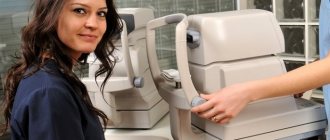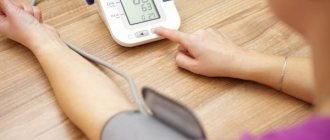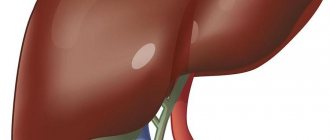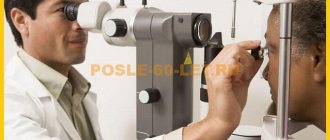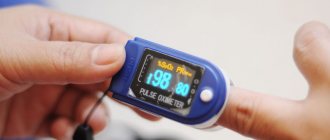To correctly measure blood pressure with an electronic tonometer, you must follow the following basic recommendations:
- take measurements in a quiet environment. 20-30 minutes before the procedure for determining blood pressure (blood pressure), refrain from psycho-emotional and physical stress, drinking strong tea, coffee and caffeine-containing drinks, alcohol;
- make sure that the batteries are functional and installed with correct polarity if a device with independent power sources is used. If the tonometer is equipped with a power supply, you must make sure that it is connected correctly and is not damaged;
- take a comfortable position (lying or sitting) during the measurement;
- During the measurement process, remain calm, do not move or talk.
Omron automatic blood pressure monitor is one of the most popular on the market
In this article:
- Principle of blood pressure measurement
- Setting up the tonometer
- What is the error of an electronic tonometer?
- How to correctly measure blood pressure with an automatic tonometer
A device for measuring blood pressure is a must-have accessory for self-diagnosis, especially in the presence of hypertension and in old age. The most convenient way to take measurements at home is to use an electronic tonometer with fully automatic functionality.
Which device should you choose?
There is a wide range of mechanical, automatic and semi-automatic models on the market. Now we will figure out which one is more accurate and reliable.
The first pressure meters appeared in 1881 in Austria, and they worked on the basis of a mercury manometer. Over time, it was equipped with a cuff, and a Russian surgeon named Korotkov began taking measurements, listening to diastolic and systolic tones.
Mechanical blood pressure monitors were eventually replaced by semi-automatic ones, which automatically calculated only blood pressure readings. Fully automatic machines appeared in South Korea and Japan much later. Many people who are determining which blood pressure monitor is best for older or younger people mistakenly choose the latest models. They are confident that modern instruments are the most accurate and reliable, but this is not entirely true.
Automatic devices
Which tonometer is more accurate - automatic or semi-automatic? There is no fundamental difference in the quality of measurements between them. Automatic models appeared in the late 90s. They are easy to use and have a large number of additional functions. To measure blood pressure, simply put on the cuff and press a button.
The built-in motor will pump the air to the desired level, and then the electronics will calculate the pulse and pressure limits, after which the information will be displayed on the display. There are two types of such tonometers and allow you to measure pressure on the wrist, finger or shoulder.
The least accurate automatic blood pressure monitor is the one that measures pressure on the finger. They work especially poorly when checking blood pressure in older people, so it is better to avoid such devices.
Semi-automatic
Like automatic ones, they calculate blood pressure and pulse themselves, and the user only needs to manually inflate the cuff with air using a bulb. Thus, a semi-automatic device is as accurate as a full automatic device.
Semi-automatic machines have fewer additional functions, but there is no urgent need for them. Also, such models are much cheaper than automatic ones and their batteries run out less often. According to hypertensive patients who are forced to measure their blood pressure themselves at home, semi-automatic tonometers are optimal. They are accurate and easy to use.
Mechanical
Such tonometers are also called sphygmomanometers. They consist of a cuff for inflation. Pressure gauge and rubber bulb with valve. Blood pressure is determined using a phonendoscope, which listens to the characteristic sounds of heartbeats.
Principle of blood pressure measurement
For more than 100 years, the mechanical method of measuring blood pressure was considered the most effective and accurate. Its feature: recording the initial and final beats of the pulse in the blood vessel on which the tonometer cuff is placed. However, in this case, the accuracy of the readings was influenced by the personal factors of the person who took the measurements: extraneous noise, hearing problems, nervousness. As a rule, medical workers prefer to use a mechanical tonometer, considering them more accurate, which is not always true.
With the invention of automatic instruments, the oscillometric method began to be used, which makes it possible to correctly measure pressure regardless of the level of external noise and the condition of the person conducting the study. Pressure fluctuations (oscillations) are recorded automatically, converted into digital values and displayed.
Factors influencing the measurement result
In addition to proper use of the tonometer, the result of taking blood pressure readings can also be affected by factors such as:
- age (in young people, normal blood pressure is considered to be 120/80 mm Hg with a permissible deviation of 10 mm Hg);
- gender (according to the observations of specialists, in women the blood pressure differs by 5-10 mm Hg from the blood pressure values of men);
- time of day (in the evening, blood pressure usually increases slightly);
- consumption of certain foods (caffeine, fried, salty, sweet and fatty foods are known to increase blood pressure);
- state of physical activity before measurement (after walking, playing sports, blood pressure increases, and at rest it returns to normal);
- the presence of bad habits (smoking and drinking even a small amount of alcohol provoke an increase in blood pressure).
To obtain the most accurate results, before using the tonometer, it is recommended to refrain from smoking, drinking strong tea and coffee, and taking medications that affect the cardiovascular system.
Blood pressure readings should not be taken immediately after drinking coffee and tea.
Setting up the tonometer
The main condition for taking measurements at home is the correct setup of the device. Therefore, when purchasing, you need to check the contents and make sure that everything is in place. Before starting work:
- Please read the instructions for use carefully.
- Insert a working battery into the slot provided for this purpose.
- Press the power button and enter the date, time, etc., if provided by the functionality.
- After this, put the cuff on your shoulder or wrist and take several control measurements to make sure the tonometer is working properly.
If you buy a device in a store or pharmacy, then the tonometer can be checked on the spot - in this case, you will be convinced of its functionality “without leaving the cash register.” When purchasing online, a reliable way is to choose a trusted supplier. The German company Beurer is one of the leaders in the global market, and their beauty and health products have received awards at international exhibitions.
Algorithm of actions
Using simple measurement rules allows you to learn how to measure your own blood pressure without any problems.
If you are starting to control your blood pressure for the first time, you need to remember the following:
- The first measurements are always taken on both hands.
- If the readings do not differ, the pressure should be measured on the non-working arm. Accordingly, for right-handers it is the left, and for left-handers it is the right.
- For different values, further measurements are taken on the limb where the value is higher.
Keep a special diary where daily indicators are recorded. If they differ by more than 5 mm. rt. Art. - repeated measurements are taken. It is necessary to carefully monitor the division scale and learn to find average values.
The most reliable types of devices are mechanical, equipped with a cuff with a “pear” for pumping air and a phonendoscope. Such devices have a simple design, low cost and are affordable for most buyers.
Anyone can learn how to measure blood pressure with a manual tonometer on their own - for this, the following algorithm of actions is observed:
- Place the cuff over your shoulder and fasten it so that your thumb fits underneath it. The lower border should be 2 cm above the level of the elbow bend.
- Place the stethoscope in the cubital fossa so that you can clearly hear the pulsation of the artery.
- Tighten the valve and start pumping air into the bulb until the pulse stops, pumping up another 20 mm. rt. Art. Then slowly open the valve.
- Listen to the pulsation and look at the built-in meter - the first sound in the phonendoscope corresponds to the upper blood pressure readings. At the moment the tones disappear, the lower blood pressure number is noted.
The sounds you hear through a phonendoscope are called Korotkoff sounds—there are five of them, and they are valuable to doctors in diagnosing heart disease. When measuring pressure, only the first (strongest) and last (quiest) noise is important - they show the upper and lower limits of blood pressure.
What is the error of an electronic tonometer?
Electronic tonometer
- This is an automatic or semi-automatic battery-powered device. In the first case, the entire process is automated; in the second, air is pumped into the cuff manually. Although doctors consider electronic devices to be less accurate, their accuracy also depends on many factors. Officially, manufacturers set the possible difference to be no more than 3 mmHg. Art. However, depending on the degree of correctness of use of the device, it may increase:
- Up to ±5 mm Hg. Art. – with a systematic component of measurement error.
- Up to ±8 mm Hg. Art. – if the error component is random.
If we take into account that the mechanical method of measuring pressure is influenced no less (and in some cases more) by external and internal factors, then confidence in the superiority of mechanical tonometers no longer looks so solid.
Common mistakes
Despite the fact that many patients are recommended to constantly measure blood pressure at home to monitor their condition for various diseases, doctors do not fully trust the values obtained. The reason is that most people make a number of mistakes when obtaining measurements, and the “false/true” factor in this case cannot be ignored.
The device produces errors most often if the hand is located at a level below or above the chest.
In the first case, the values will be lower than real ones. In the second, the device can independently begin to pump additional air into the cuff, and the true readings will be lost. But you can get an overestimated blood pressure value if you sit with a straight or bent back, without leaning on any surface. The muscles will be stiff and this will skew the final figure. The same upward result will be obtained if the cuff is tightened very tightly.
When putting the cuff on your forearm, remember: the arm should be bare, but you cannot roll up the sleeves, otherwise you will pinch the arteries.
Many people forget to check the device before measuring pressure. Don’t be lazy and calibrate its value: in the correct state, the arrow is located along ) - relevant for mechanical tonometers.
If the cuff is not tightened tightly enough or there is a defect in it, air will be pumped in slowly and this will increase the blood pressure monitor reading.
What else to consider?
Remember that when measuring blood pressure, you must be in a state of absolute rest: turning on the TV, smartphone, or talking out loud will certainly distort the final results. It is also not recommended to eat or drink any drinks (especially coffee and alcohol) before the procedure.
Perhaps the most common mistake is taking indicators “one by one”. In other words, having received a value that seems dubious to him, the patient does not take a break, but immediately, without loosening the cuff, takes the second and third blood pressure values. This inevitably leads to distorted results.
Recommendations for fixing errors
Measure the pressure in a room where you will not be disturbed by strangers. Even the sound of a conversation between two or three people can distort the operation of the tonometer. If you find it difficult to put on the cuff yourself, ask someone close to you to help, but do not gather a group of friends or even family members in the room.
Get rid of tight clothing and loosen your collar. If your outerwear has long sleeves, it is better to remove the pullover or shirt, but do not roll up the sleeve at the elbow. Remove the abdominal belt and any headgear. You can also temporarily remove your glasses.
Try to sit in the most natural position possible, find support for your back, place your feet completely on the floor. Keep your head straight, but without tension. You should breathe freely, but at the same time keep all movements to a minimum.
When tightening the cuff, follow the instructions as closely as possible. If the cuff has an arrow-shaped indicator indicating the direction of the main artery (usually modern blood pressure monitors have indicators for the right and left arms), rotate it according to the indicated movement. The cuff should fit tightly on the forearm, but until air is pumped into it, no discomfort should appear.
If, while measuring your blood pressure, you feel fear or worry about future results, this will definitely affect your blood pressure value (most likely upward). Stay optimistic and try to ignore your worries during the procedure.
How to correctly measure blood pressure with an automatic tonometer
The amount of error in measurements with any type of instrument depends on a few simple rules that must be followed to obtain accurate data:
- When using the “shoulder” device, place the cuff 2 cm above the elbow bend and place your arm freely on the table.
- If a person uses a wrist-based blood pressure monitor, the cuff should still be at heart level.
- To obtain correct data, do not tighten the cuff too tightly.
- Carry out research 2 times with an interval of 2-3 minutes. and choose the average value.
- Measure your blood pressure at the same time of day - this will ensure the most identical state of the body and reduce the likelihood of error.
- Before taking measurements, try to rest for at least 5 minutes; about an hour before measurements, do not drink alcohol, coffee, tea, or energy drinks.
- Take measurements 2-3 times. per day, especially with existing hypertension or in old age.
- Record your readings in a diary and take them with you to your doctor's appointment.
Check the serviceability of the device 2 times a year - this will guarantee the reliability of the measurements. Wrist blood pressure monitors are recommended for young and middle-aged people. For older people, when changes in blood vessels begin, a tonometer on the shoulder is more suitable. If you decide to purchase a semi-automatic model, make sure that the person using the tonometer can operate the bulb independently.
Useful tips and common mistakes
Often incorrect blood pressure results are mistaken for a defect in the digital device, however, in some cases the unreliability of the indicators depends on the patient himself. Here are the most common mistakes people make when using the device:
- The requirements for instrumental research are not met, for example, being in an active state, talking at the time of measurement, incorrectly wearing the cuff, etc.
- The arm on which the cuff is applied is suspended.
- Compression of the upper limb by clothing.
- Turn on the device before putting on the cuff.
- Incorrect hose position.
- The cuff is too tight or too loose.
- Failure to observe the interval for taking measurements on the same upper limb (the optimal interval is 2-3 minutes).
- The cuff is worn on top of clothing and any jewelry.
- The cuff is too high or too low relative to the elbow joint.
If the patient doubts the results of repeated studies, it is recommended to carry out a control measurement of blood pressure using a mechanical device. It is better to do this in a medical institution by contacting a specialist.
The photo shows an incorrect procedure for measuring pressure; the hand is in a suspended state, and therefore under tension.
To avoid making common mistakes, you should follow these useful tips:
- reflect the results of each measurement in a diary indicating the date, time of day and the value of systolic, diastolic pressure and heart rate;
- periodically check the data of the digital device with a mechanical tonometer;
- take blood pressure measurements on both arms with an interval of 2-3 minutes.
The reliability of the study is achieved by measuring blood pressure three times over a short period of time, the differences between which are no more than 5 mm. Hg Art.
To determine the dynamics of the disease and the effectiveness of drug therapy, the doctor strongly advises patients to keep a diary of blood pressure readings. It is required for:
- confirmation of the effectiveness of the prescribed therapy;
- determining the exact dynamics of the disease;
- improving the quality of life by eliminating provoking factors;
- reducing the risk of the consequences of cardiovascular pathologies.
For the doctor, this diary serves as the basis for continuing or adjusting the prescribed therapy. If, according to the identified study indicators, there is a weak dynamics of recovery, the attending physician must find the reason for the current trend; perhaps the reason lies in the patient’s lifestyle, and for this it is worth eliminating, for example, bad habits and the patient’s condition will noticeably improve.
The doctor may oblige you to keep such a diary in the following situations:
- Hypertension of any type.
- Hypertension in pregnant women.
- Hypotension.
- Nephropathy during pregnancy.
- Neurocirculatory dystonia.
- Insufficiency of the respiratory system.
- Angina pectoris.
- Imbalance of lipid and carbohydrate metabolism.
- Apnea syndrome.
- Vegetative-vascular dystonia.
Let us note that pregnancy is a period during which a woman is obliged to carefully monitor her health. Therefore, if there is evidence, keeping a diary should be the responsibility of the expectant mother, because the health of her child depends on it. If treatment for the disease in a pregnant woman is ineffective, this can lead to gestosis and even miscarriage. And with serious pathological processes, the risk of maternal death at the time of delivery increases.
During pregnancy, special monitoring of blood pressure is required.
Advice. Before visiting a doctor, patients should monitor their indicators for 2 weeks.
Recommendations for keeping a diary:
- On the first page, you must fill in the patient’s personal data: full name without abbreviations, age, blood type, body weight at the start of the study, date the diary started, telephone number.
- It is important to highlight the “drugs” column. This will reveal trends in the effectiveness of medications taken.
- The measurement table should indicate the date and time of the procedure.
- If some measurements were made with a mechanical device, this should be reflected.
If the diary schedule is violated, for example, the absence of 2 or more measurements in Table 2, the results obtained can be considered useless.
There are many diary template options available online. We will present to our readers, in our opinion, the most convenient and easiest to fill out sample of this document.
Table No. 3. Sample of filling out a diary.
| Measurement date | Times of Day | Indicators | Medications taken | Patient's condition | ||
| Systolic | Diastolic | Heart rate | ||||
| 08.09.2018 | 8.00 | 125 | 75 | 71 | No-shpa | Feeling normal |
| 20.00 | 145 | 85 | 85 | Betaxolol | Headache after troubles at work | |
| 21.30 | 122 | 75 | 71 | — | Feeling better after a walk in the fresh air | |
| 09.09.2018 | 8.00 | 135 | 85 | 80 | Calming herbal mixture, Betaxolol | Woke up feeling depressed |
| 20.00 | 123 | 81 | 74 | Feeling better after a walk outside | ||
Keeping a diary allows you to establish the trend of events and study results, as well as determine the effectiveness of the medications taken.
How to measure the pressure on the shoulder at the elbow?
Measuring indicators in the elbow bend is considered a traditional method. For the session you need:
- sit on a chair and take a comfortable position;
- place your hand on a hard surface, such as a table. Remember that the limb should be at the same level as the heart;
- There should be no tight clothing or accessories on the shoulder. If necessary, remove your jacket or dress;
- When fastening the cuff, make sure that there are no unnecessary folds on it. Also, do not tighten the material too tightly: make sure that your finger fits comfortably under the cuff and that the elbow bend is not pinched.
If you doubt the reliability of the numbers obtained, repeat the session after 10-15 minutes.
Important! To obtain accurate results, a right-handed person should take measurements on his right hand, and a left-handed person should take measurements on his left. For an adult, choose a device with a cuff that is at least 14 cm wide and 30 cm long.
The need to check the tonometer for accuracy
When using a tonometer, it is important to be able to maintain it, know how to identify errors and adjust it. As standard, new out of the box, the blood pressure meter is already calibrated and ready for use after unpacking without any manipulation.
Although less common, there are devices that need to be adjusted before use, for example, if the product was stored in a warehouse for a long time, experienced factors that reduce accuracy (temperature changes, etc.) or initially had deviations.
But basically, checking the tonometer and monitoring the correctness of the measurements is required after a certain period of using the device, and also even if it was used only a few times, after which it was stored idle. If the device is electronic, then over time faults appear in its circuits, and the mechanical parts also “get tired”. Such phenomena are natural and do not mean a breakdown.
Checking and calibrating the tonometer will also be required after its repair.


